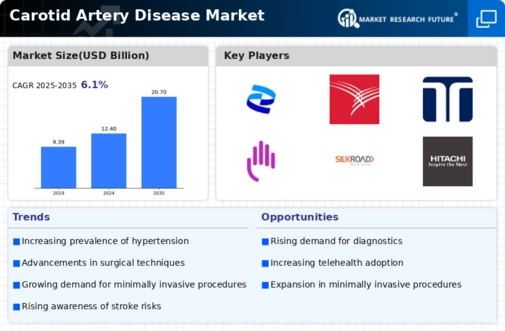Market Analysis
In-depth Analysis of Carotid Artery Disease Market Industry Landscape
The market dynamics of carotid artery disease treatment are influenced by various factors that impact supply, demand, pricing, innovation, and regulation within the sector. Carotid artery disease refers to the narrowing or blockage of the carotid arteries, which supply oxygen-rich blood to the brain, often leading to serious health risks such as stroke. Treatment options range from lifestyle changes and medication to surgical interventions, each playing a role in shaping the market dynamics.
Supply in this market is primarily driven by advancements in medical technology and manufacturing capabilities. Medical device companies invest heavily in research and development to create innovative products for the diagnosis and treatment of carotid artery disease. These include devices such as carotid artery stents, angioplasty balloons, embolic protection devices, and surgical instruments used in procedures like carotid endarterectomy. Additionally, stringent regulatory requirements ensure that these products meet safety and efficacy standards before entering the market, contributing to a steady supply of approved treatments.
On the demand side, several factors contribute to the need for carotid artery disease treatment. Aging populations, unhealthy lifestyles, and increasing prevalence of risk factors such as hypertension, diabetes, and smoking drive the demand for interventions to prevent or manage carotid artery disease. Moreover, advancements in medical imaging technologies enable early detection and diagnosis of carotid artery disease, leading to increased demand for treatment options to mitigate the risk of stroke and other complications.
Pricing dynamics in the carotid artery disease treatment market are influenced by factors such as product efficacy, market competition, reimbursement policies, and healthcare economics. Innovative treatments and devices may command premium prices, especially if they offer superior outcomes or reduced procedural risks compared to conventional therapies. However, pricing pressures from healthcare payers and regulatory bodies may constrain reimbursement rates, impacting the affordability and accessibility of treatments for patients.
Innovation plays a crucial role in shaping the market dynamics of carotid artery disease treatment. Medical device companies continually invest in research and development to improve existing treatments and develop novel therapies for better patient outcomes. Technological advancements such as minimally invasive procedures, novel stent designs, and integrated imaging systems enhance the safety, efficacy, and convenience of carotid artery disease treatments, driving innovation within the industry.
Regulatory compliance is a significant consideration for companies operating in the carotid artery disease treatment market. Medical devices used in the diagnosis and treatment of carotid artery disease are subject to regulatory oversight by agencies such as the FDA in the United States and similar authorities worldwide. Compliance with regulatory requirements ensures the safety, efficacy, and quality of treatments, instilling confidence in healthcare providers and patients.
Market competition in the carotid artery disease treatment industry is intense, with several established players and emerging companies competing for market share. Established medical device manufacturers leverage their experience, brand reputation, and distribution networks to maintain a competitive edge. Meanwhile, smaller companies focus on innovation, niche markets, and strategic partnerships to differentiate themselves and gain market traction.
Geopolitical factors also influence the market dynamics of carotid artery disease treatment. Healthcare policies, government funding, reimbursement systems, and public health initiatives impact the adoption and utilization of treatments for carotid artery disease. Moreover, regional variations in disease prevalence, healthcare infrastructure, and patient demographics create diverse market conditions and opportunities for manufacturers.









Leave a Comment